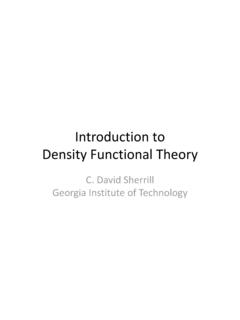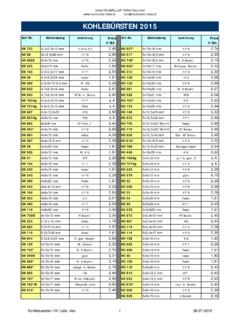Transcription of A Brief Review of Elementary Quantum Chemistry
1 A BriefReviewofElementaryQuantumChemistryC . DavidSherrillSchool of ChemistryandBiochemistryGeorgiaInstitute of TechnologyLastRevisedon27 January20011 Contents1 .. ect.. ElectronicAngularMomentum..62 TheSchr Schr odingerEquation.. Schr odingerEquation..103 .. Operators.. QuantumMechanics.. QuantumMechanics..204 Postulatesof QuantumMechanics265 a Box ..316 ..357 .. theNuclearHamiltonian..438 Many-ElectronWavefunctions..4831 TheMotivationforQuantumMechanicsPhysicis tsat theendof thenineteenth centurybelievedthatmostof thefunda-mentalphysicallawshadbeenworked nementsto get\anextradecimalplace"of accuracy. Asit turnsout,the eldof physicswas transformedprofoundlyin theearlytwentiethcenturyby Einstein'sdiscoveryof relativity andby thedevelopment of hashadfairlylittleimpactonchemistry, allof theoreticalchemistryis of quantummechanicswasinitiallymotivatedby two ob-servationswhich demonstratedtheinadeqacyof \ultravioletcatastrophe"andthephotoelect rice anidealizedobjectwhich usedto derive anequationwhich describes theintensity ofblackbodyradiationas a functionof frequencyfora xedtemperature|theresultis knownas worksforlow frequencies,it divergesas 2.
2 Thisdivergenceforhighfrequenciesis explainedtheblackbodyradiationin 1900by assumingthattheenergiesof theoscillationsof electronswhich gave riseto theradiationmustbeproportionalto integralmultiplesof thefrequency, ,E=nh (1)Usingstatisticalmechanics,Planck derivedanequationsimilarto theRayleigh-Jeansequation,butwiththeadju stableparameterh. Planck foundthatforh=6:626 10 34J s, theexperimentaldatacouldbe ,Planckcouldnoto era good justi cationforhisassumptionof thisenergyquantizationideaseriouslyuntil Einsteininvoked a similarassumptionto explainthephotoelectrice ectIn 1886and1887,Heinrich Hertzdiscoveredthatultravioletlight cancauseelec-tronsto be ejectedfroma theclassicalwave theoryof light, theintensity of thelight determinestheamplitudeof thewave, andso agreaterlight intensity shouldcausetheelectronson themetalto oscillatemorevi-olentlyandto be ejectedwitha greaterkineticenergy.
3 In contrast,theexperimentshowedthatthekinet icenergyof theejectedelectronsdependsonthefrequency of thelight. Thelight intensity a ectsonlythenumber of thephotoelectrice ectin by Planck'sformula(1),Einsteinassumedthatth eradiationitselfconsistedof packetsof energyE=h ,which arenow ectusingthisassumption,andhe calculateda valueofhcloseto thatobtainedby yearslater,Einsteinshowedthatnotonlyis light quantized,butso atconstant volume(Cv) of a crystalis 3R, whereRis themolargasconstant. Thisworkswellforhightemperatures,butforl ow ableto explainthisresultby assumingthattheoscillationsof atomsabouttheirequilibriumpositionsarequ antizedaccordingtoE=nh ,Planck' important evenfora systemof atomsin acrystal,which shouldbe well-modeledby a systemof massesandsprings( ,byclassicalmechanics). ElectronicAngularMomentumRutherfordpropo sedthatelectronsorbitaboutthenucleusof an that,classically, orbitingelectronsexperiencea centripetalacceleration,andacceleratingc hargesloseenergyby radiating;a stableelectronicorbitis h(2)Quantizationof angularmomentummeansthattheradiusof theorbitandtheenergywillbe quantizedas thehydrogenatomweredueto transitionsof anelectronfromoneallowedorbit/energyto acquiredor releasedin theformof a photonas proposedby Einstein,so that E=h (3)Thisis knownas theBohrfrequencycondition.
4 Thiscondition,alongwithBohr'sexpressionf ortheallowedenergylevels,gives a good match to ,it a photonisp=h (4)Thiscanbe easilyshownas fora photonand =cforanelectromagneticwave, we obtainE=hc (5)Now we useEinstein'srelativity resultE=mc2to nd =hmc(6)6which is equivalent to equation(4).Notethatmrefersto therelativisticmass,nottherestmass,since therestmassof a photonis canbehavebothas a wave (itcanbe di racted,andit hasa wavelength),andas a particle(itcontainspacketsof energyh ), deBrogliereasonedin 1924thatmatteralsocanexhibitthiswave-par ticleduality. Hefurtherreasonedthatmatterwouldobeythes ameequation(4) ,DavissonandGermerobserveddi ractionpatternsby bombardingmetalswithelectrons,con rmingde Broglie' 'sequationo ersa justi cationforBohr'sassumption(2).If wethinkof anelectronas a wave, thenfortheelectronorbitto be stablethewavemustcompleteanintegralnumbe r of , be writtenas2 r=n (7)If we usethedeBroglierelation(4),thiscanbe rewrittenasmvr=n h(8)which is identicalto Bohr'sequation(2).
5 Althoughde Broglie'sequationjusti esBohr'squantizationassumption,it alsodemonstratesa de ciencyof Bohr' leadsto thefamousuncertainty principle x p h(9)Oneresultof theuncertainty principleis thatif theorbitalradiusof anelectronin anatomris knownexactly, thentheangularmomentummustbe 'smodelis thatit speci esrexactlyandit alsospeci esthattheorbitalangularmomentummustbe anintegralmultipleof thestagewas setfora newquantumtheorywhich was consistent withtheuncertainty odingerEquationIn 1925,ErwinSchr odingerandWernerHeisenbergindependentlyd evelopedthenewquantumtheory. Schr odinger'smethod involves partialdi erentialequations,whereasHeisenberg'smet hod employsmatrices;however,a yearlaterthetwomethods wereshownto be mathematicallyequivalent. MosttextbooksbeginwithSchr odinger'sequation,sinceit seemsto have a betterphysicalinterpretationviatheclassi calwave ,theSchr odingerequationcanbe viewed as aformof thewave equationappliedto Schr odingerEquationHerewe follow thetreatment of McQuarrie[1], startwiththeone-dimensionalclassicalwave equation,@2u@x2=1v2@2u@t2(10)Byintroduci ngtheseparationof variablesu(x;t) = (x)f(t)(11)we obtainf(t)d2 (x)dx2=1v2 (x)d2f(t)dt2(12)If we introduceoneof thestandardwave equationsolutionsforf(t) such asei!
6 T(theconstant canbe takencareof laterin thenormalization),we obtaind2 (x)dx2= !2v2 (x)(13)Now we have anordinarydi erentialequationdescribingthespatialampl itudeofthematterwave as a functionof a particleis thesumofkineticandpotentialpartsE=p22m+V (x)(14)8which canbe solved forthemomentum,p, to obtainp=f2m[E V(x)]g1=2(15)Now we canusethede Broglieformula(4)to getan expressionforthewavelength =hp=hf2m[E V(x)]g1=2(16)Theterm!2=v2in equation(13)canbe rewrittenin termsof if we recallthat!= 2 and =v.!2v2=4 2 2v2=4 2 2=2m[E V(x)] h2(17)Whenthisresultis substitutedinto equation(13)we obtainthefamoustime-independentSchr odingerequationd2 (x)dx2+2m h2[E V(x)] (x) = 0(18)which is almostalways writtenin theform h22md2 (x)dx2+V(x) (x) =E (x)(19)Thissingle-particleone-dimensiona lequationcaneasilybe extendedto thecaseof threedimensions,whereit becomes h22mr2 (r) +V(r) (r) =E (r)(20)A two-bodyproblemcanalsobe treatedby thisequationif themassmis replacedwitha reducedmass.
7 It is important to point outthatthisanalogywiththeclassicalwave equationonlygoes so cannot,forinstance,derive thetime-dependentSchr odingerequationin ananalogousfashion(forinstance,thatequat ioninvolves thepartial rstderivative withrespectto timeinsteadof thepartialsecondderivative).Infact,Schr odingerpresentedhistime-independent equation rst,andthenwentback andpostulatedthemoregeneraltime-dependen t Schr odingerEquationWe arenow readyto considerthetime-dependent Schr wereableto derive thesingle-particletime-independent Schr odingerequationstartingfromtheclassicalw ave equationandthedeBroglierelation,thetime- dependent Schr odingerequationcannotbe derived usingelementarymethods andis generallygivenas a postulateof is possibleto showthatthetime-dependent equationis at leastreasonableif notderivable,butthearguments areratherinvolved ( [2], ;Levine[3], ).
8 Thesingle-particlethree-dimensionaltime- dependent Schr odingerequationisi h@ (r;t)@t= h22mr2 (r;t) +V(r) (r;t)(21)whereVis assumedto be a realfunctionandrepresents thepotentialenergyofthesystem(a complexfunctionVwillactas a sourceor sinkforprobability, asshownin Merzbacher[2], ).WaveMechanicsis thebranch of quantummechanicswithequation(21)as (21)doesnotyet account forspinor relativistice coursethetime-dependent equationcanbe usedto derive we writethewavefunctionas a productof spatialandtemporalterms, (r;t) = (r)f(t), thenequation(21)becomes (r)i hdf(t)dt=f(t)24 h22mr2+V(r)35 (r)(22)ori hf(t)dfdt=1 (r)24 h22mr2+V(r)35 (r)(23)Sincetheleft-handsideis a functionoftonlyandtheright handsideis a functionofronly, thetwo sidesmustequala constant. If we tentativelydesignatethisconstantE(sincet heright-handsideclearlymusthave thedimensionsof energy),10thenwe extracttwo ordinarydi erentialequations,namely1f(t)df(t)dt= iE h(24)and h22mr2 (r) +V(r) (r) =E (r)(25)Thelatterequationis onceagainthetime-independent Schr easilysolved to yieldf(t) =e iEt= h(26)TheHamiltonianin equation(25)is a Hermitianoperator,andtheeigenvaluesof a Hermitianoperatormustbe real,soEis (t) arepurelyoscillatory, sincef(t) never changesin magnitude(recallEuler'sformulae i =cos i sin ).
9 Thus if (r;t) = (r)e iEt= h(27)thenthetotalwave function (r;t) di ersfrom (r) onlyby a phasefactorofconstant all,thequantityj (r;t)j2is timeindependent, as we caneasilyshow:j (r;t)j2= (r;t) (r;t) =eiEt= h (r)e iEt= h (r) = (r) (r)(28)Secondly, theexpectationvalueforany time-independent operatoris alsotime-independent, if (r;t) satis esequation(27).Bythesamereasoningapplied above,< A >=Z (r;t)^A (r;t) =Z (r)^A (r)(29)For thesereasons,wave functionsof theform(27) (r;t) is \stationary," buttheparticleit describes is not!Ofcourseequation(27)represents a particularsolutionto equation(21).Thegeneralsolutionto equation(21)willbe a linearcombinationof theseparticularsolutions, (r;t) =Xicie iEit= h i(r)(30) [3]de nesanoperatoras\arulethattransformsa givenfunctionintoanotherfunction"( ).Thedi erentationoperatord=dxis anexample|it transformsa di erentiablefunctionf(x) into anotherfunctionf0(x).
10 Otherexamplesincludeintegration,thesquar eroot,andso operators(theymultiplya function).McQuarrie[1]gives anevenmoregeneralde nitionforanoperator:\Anoperatoris a symbol thattellsyoutodosomethingwithwhatever followsthesymbol"( ).Perhapsthisde nitionis moreappropriateif we want to referto the^C3operatoractingonNH3, quantummechanics,physicalobservables( ,energy, momentum,position,etc.)arerepresentedmat hematicallyby instance,theoperatorcorrespondingto energyis theHamiltonianoperator^H= h22Xi1mir2i+V(31)whereiis anindexover alltheparticlesof have alreadyencoun-teredthesingle-particleHam iltonianin equation(25).Theaveragevalueof anobservableA representedby anoperator^Afora quantummolecularstate (r) isgivenby the\expectationvalue"formula< A >=Z (r)^A (r)dr(32) OperatorsMostof thepropertiesof operatorsareobvious,buttheyaresummarized belowforcompleteness.











